#very human
Text



I really liked this book, not understanding the Phase 2 hate tbh
#This scene was also just super cool#very human#skulduggery pleasant#valkyrie cain#omen darkly#auger darkly#razzia#nero#bedlam#skulduggery pleasant bedlam#tw blood#tw death#bedlam spoilers#skeleton#stylus#nic stylus#digital art#art
29 notes
·
View notes
Note
2 & 10 for the ask thing?
Maeve is adorable, I love her :D
Whaaa!! Aw, thank you so much! I'm so glad people like her!
2. Describe their tent setup! What’s on the outside? The inside?
Ohhh this is good. (Mostly because I can base it on my LARP tent in real life, hehe!)
Maeve values comfort. Her camp setup is a little beige bell tent, with a small awning casting shade onto a large pile of cushions and pillows, laid out carefully on a green rug. There's a small table, which has far too many used cups on it, which she should probably pick up, but has yet to do so. A book, with a leaf haphazardly tossed in as a bookmark.
On the inside, the place is piled high with furs and blankets and even more pillows. You cannot see the floor. She would make a nest, if she could. Drying herbs hang from the ceiling, to make the whole place smell like home.
I also think she has a small chest just outside her door, filled to the brim with salves and bandages, and most importantly, little snacks and treats.
10. Does your Tav have a last name? Is there a meaning behind it?
Tilling! Her full name is Maeve Tilling! This may seem a little silly, but it's lifted directly from The Tale of Desperaeux. (Highly recommend this book, even for adults, it holds my heart.) Desperaeux Tilling is a teeny tiny mouse, who struggles in his home because he doesn't conform to the expectations of those around him. He's small and fearful, but grows to be so courageous and strong, trusting in himself enough to save the people he loves, sword (needle) in hand.
Maeve is a teeny tiny woman, who struggles in her home, because she couldn't conform to the expectations of her mother. She starts out small and fearful, but grows to be courageous and strong, and saves all of Faerun with halberd in hand.
Thus, Maeve Tilling.
#also her last name would canonically be her step father's last name#the thing she shares with her brothers#very human
3 notes
·
View notes
Text
4 notes
·
View notes
Text
so as humans fashion a figure from clay the gods fashion humans from clay?
1 note
·
View note
Text
Ah my joy in those competent, steely, experienced pilots who stay in control and try weird shit that works and saves everyone on the plane. Usually, they also have to defy someone in charge/make a crucial decision on their own and that takes confidence with the experience.
(But also time. Some pilots have the time to make these decisions and some just have seconds. Most humans will fuck up in a panicked few seconds, and even a small fuck up can matter in that length of time.)
#you can ignore me#sometimes i find disaster shows soothing i don't know why#maybe it gives my anxiety an outlet idk#but catastrophes generally have several causes and i find it fascinating#and horrible#very human
10 notes
·
View notes
Note
(Anon thoughts) I wonder what kinds of super cool human stuff she's done?

" suuu many cul human things!! just ask!! "
1 note
·
View note
Text
Squinted at the raws today and hoo boi, the Parsians really were holding massive grudges, weren't they?
In the dialogue (and not even all dialogue just the small part I focused on) I found:
Someone whose father's eyeballs were presumably gouged out
An old woman whose son and grandson were murdered
A man shouting “let me have revenge for my wife!” it's unclear what happened to his wife but as we can probably assume: nothing good
And in the earlier arcs and chapters of ArSen as a whole there were Lusitanians bragging about how they cooked a child and force-fed it to its parents, in the arc where Kubard, Merlaine, and the locals of Daylam fought against Lusitanians the latter were shown to have a baby skewered on one of the spears, so on and so forth, yeah is it a wonder the Parsians are so pissed?
#the brutality was uncomfortable to watch but it was so human#very human#all the gritty and ugly parts#the raw emotion#also... intentional or not there is a parallel to be drawn between Hilmes and the citizens of Ecbatana in this chapter#arslan senki#the heroic legend of arslan#heroic legend of arslan
3 notes
·
View notes
Photo


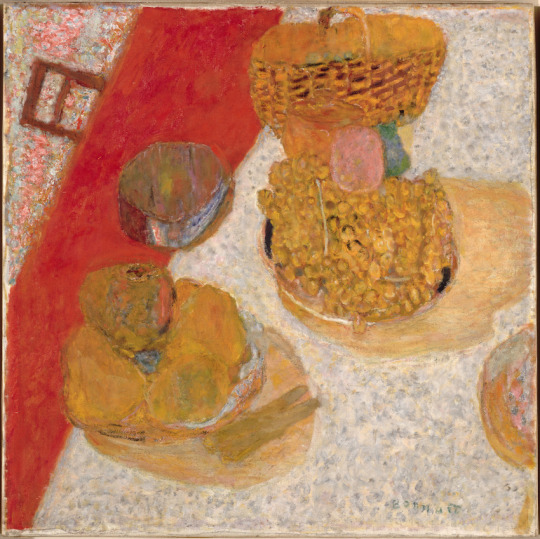
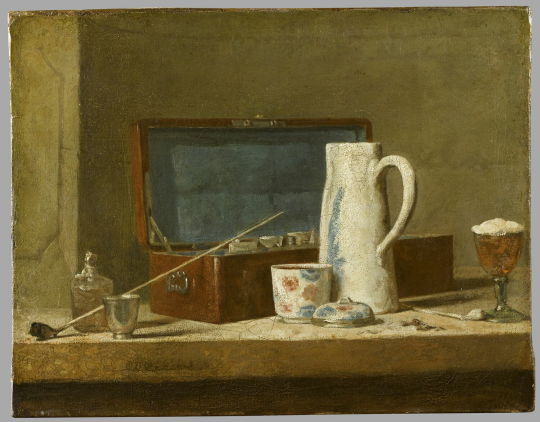
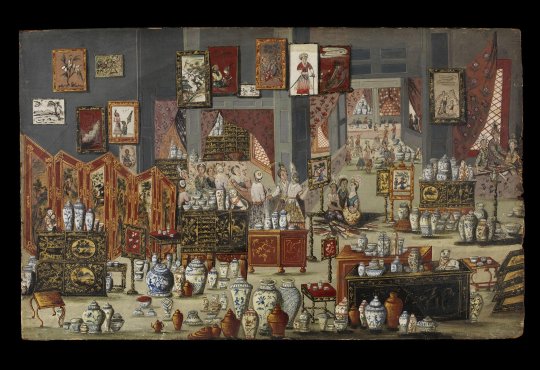



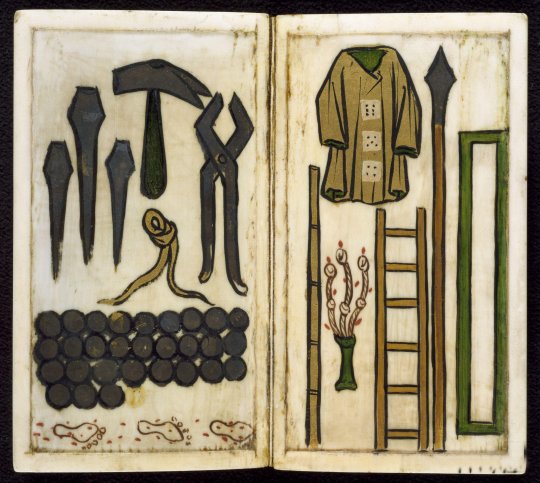
Some of the artworks featured in the exhibition Les Choses, at The Louvre (click for full picture)
Cartels de l’exposition pour ces œuvres :
- Pain et Figues, 50-79 de notre ère, peinture murale, Herculanum
Dans ce tableautin très simple, deux figues brunes et un pain doré renvoient à une grande frugalité, que la douceur des fruits, vantée par Pline l’Ancien dans son Histoire naturelle (an 77), tempère à peine. Et pour cause : il n’est pas question ici de susciter l’envie, la gourmandise, mais d’exprimer le contraire, un idéal de diète “philosophique”, dont Socrate (vers 470/469-399 avant notre ère), le mangeur de pain, est le parangon, lui qui critiquait les plus gloutons de ses contemporains. Dans leur dénuement, ces petites choses du quotidien ont leur morale sévère qui en impose.
- Schädel [Crâne], 1983, Gerhard Richter
Au début des années 1980, Richter est fasciné par le motif du crâne, qui lui offre de mettre à distance ses effets, de les canaliser, en inscrivant sa peinture dans la tradition. Il prend alors le contre-pied de la peinture néo-expressionniste allemande, spontanée, subjective, violente. Rien de tel ici, où le memento mori tend même à s’effacer derrière les moyens de la peinture : la géométrie impeccable, la rigueur minimale, le quasi-monochrome. Seule la lumière dégage la coquille renversée du crâne, et rappelle in fine le sens d’une vanité appliquée aux illusions et aux certitudes du siècle.
- Coin de table, 1934, Pierre Bonnard
Sur cette toile presque carrée, rien n’est facilement identifiable. Bonnard ne s’intéresse pas à la représentation mimétique des choses, mais à la beauté simple du quotidien et à ses sensations. Ce Coin de table est un prétexte à expérimenter les moyens de les exprimer : format et cadrage, vue en surplomb des objets, étirés, aplatis, ployés, fusionnés, jeu de la lumière qui émane de la matière picturale elle-même, travaillée d’une touche virtuose. Après Chardin, Bonnard fait encore de la nature morte le lien où se manifeste une magie énigmatique.
- Pipes et vases à boire, dit La Tabagie, vers 1737, Jean Siméon Chardin
Chardin a représenté une série d’objets qu’il possédait, de petites choses sans qualité extraordinaire, en particulier une tabagie de palissandre. La grande simplicité, l’équilibre de l’ensemble sont remarquables. Tout s’assemble, tout s’épanouit harmonieusement pour suggérer le charme de la vie telle qu’elle est, dans ses choses mêmes. Diderot prêtait une magie singulière à la peinture de Chardin. Cette Tabagie la contient, où agit le mystère de la présence des choses, comme des personnages de l’histoire, animées d’un mouvement et d’une lumière intérieure.
- Intérieur d’un magasin de porcelaines et d’objets chinois, 1680-1700, peintre anonyme néerlandais
Un anonyme néerlandais, fasciné comme nombre de ses contemporains par les objets de luxe asiatiques, s’est inspiré des représentations de cabinets de collectionneurs pour inventer une boutique imaginaire qui rassemble avec fantaisie et jubilation tous ces trésors tant convoités. L’artiste a peint cette chinoiserie sur une feuille d’éventail, lui-même un article de luxe décrivant les merveilles d’Orient et d’Extrême-Orient. Une fois mise au carré pour être encadrée, cette feuille est devenue à son tour un objet d’art européen ouvrant sur le vaste monde.
- Natura Morta, 1944, Giorgio Morandi
Cette nature morte est exemplaire de l’art de Morandi à traduire le mystère et la poésie des choses. L’artiste a élu des objets simples, ordinaires, qu’il collectionnait, et il les a mis en scène selon un dispositif réglé, avec une grande économie de moyens. Disposés en frise sur un fond neutre, de formes et de hauteurs différentes, peints dans des harmonies sourdes de blanc nacré rompues par la boule de hochet jaune et bleue, ils sont comme figés dans le temps, silencieux et secrets. Morandi les a ainsi rendus présents au monde d’une manière qui excède leur fonction, intrigants, voir obsédants.
- La Chambre de Van Gogh à Arles, 1889, Vincent Van Gogh
Pour Van Gogh, sa chambre de sa maison jaune, à Arles, devait être très simple et “vide”, comme un intérieur japonais. Il détestait les choses de la bourgeoisie, l’accumulation des bibelots, source de confusion mentale. Il lui fallait de l’ordre, et ce tableau devait créer les conditions du repos, une sorte d’asile de paix, avec juste les choses nécessaires, où calmer la tête et l’imagination. L’artiste devait tenir à cette projection mentale rassurante, qui le dépeint en creux : la première peinture de cette chambre (1888) ayant été endommagée, il la refit en effet deux fois (1889).
- Six coquillages sur une table de pierre, 1696, Adriaen Coorte
Une sorte de paradoxe gît dans cette petite composition, d’une infinie délicatesse, où ces quelques coquillages, presque insignifiants de prime abord, renvoient pourtant à la puissance de l’économie coloniale néerlandaise, fondée sur la Compagnie des Indes orientales depuis 1602. Tous, en effet, viennent des mers du Sud, rapportés par bateaux. Alors que le goût des curiosités se développait en Europe, au contact d’autres mondes, les tableautins de Coorte devaient être appréciés par des collectionneurs qui doublaient leurs précieux trésors de leurs représentations.
- Livret de dévotion, vers 1330-1340, ivoire polychrome et doré, Cologne
Ce double feuillet représentant les Arma Christi (les “Armes du Christ”) fait partie d’un petit livret de dévotion. Aux scènes de la Passion du Christ, qui y sont également représentées, sans texte, répondent les instruments de cette Passion, soigneusement inventoriés dans l’image : des trente deniers reçus par Judas pour prix de sa trahison au tombeau vide, en passant par le roseau et le fouet de la flagellation. Rien ne manque, excepté le Christ lui-même, absent, mais présent dans chacune de ces choses qui devaient faire récit, engager à la prière et à la méditation.
#art#still life#vincent van gogh#giorgio morandi#pierre bonnard#gerhard richter#jean-baptiste-siméon chardin#i really liked this exhibition#there was something very moving about it#very human#bibi#one of the first artworks in the exhibition is the 'pain et figues' one and it's also one of the oldest featured#and idk i got a little emotional seeing it
1 note
·
View note
Text
My grandfather and my godfather (a beloved neighbor and dear family friend) had a long standing bet- for one dollar- about who would die first. Both of them being slightly pessimistic (in the funny way), they both insisted that they themselves would be the first to die. Any time my grandfather had a health scare, he’d gleefully call up my godfather to boast that he’d be passing “any day now” and he was sure to win the bet. It was a big family joke and they were always amiably sparring and comparing notes about who was in worse shape, medically speaking.
When my grandfather was in hospice care dying of liver cancer, my godfather was quite ill also. It took him great effort to make the journey to see his dying friend. As he came into the room, supported by a family member, he shuffled to my grandpa’s bedside and silently handed him a dollar bill. He was ceding his loss of the bet, as they both knew who was going first. My grandpa had been in quite bad shape for a while and was no longer able to speak but let me tell you he snatched that dollar with unexpected strength and literally laughed aloud. He knew exactly what the gesture meant and he couldn’t help but find the humor within the grief. It was the last time any of us heard my grandpa laugh, as he passed shortly after.
When I talk about my appreciation for “dark humor” I’m not so much thinking about edgy jokes, but rather the human instinct to somehow, impossibly, both find and appreciate the absurdity that is so often folded into the profound grief of life and death. When I tell this story I think it kind of perturbs people sometimes, but it’s honestly one of my favorite memories about two men I really deeply admired. I could never hope for anything more than for my loved ones to remember me laughing until the very end, and taking joy in a little joke as one of my final acts.
#I think almost anyone in medicine will understand this#to absent friends!#gallows humor is a very human way to cope#death#grief#dark humor#illness
44K notes
·
View notes
Text
Love the contrast between the Americans’ “Apollo” and the Soviets’ “Sputnik.” You got the Americans naming their rocket after a Greek god trying to communicate the grandness and importance of this rocket. And you got the Soviets naming their rocket “fellow traveler.” Like a friend you go on an adventure with together. This rocket is our little friend lol
#i think its cute#they took the mars rover approach#humanizing the space craft making it cute making us (me) project emotions onto it#the soviets also used imagery of laika in propaganda a lot#which is pretty fucked up imo#but if i grew up in the soviet union that shit wouldve definetly worked on me lmao#the narrative of a heroic little dog going to space and being honored by the whole country#as cruely wrong as it is its very appealing#the soviets knew what they were doing man they didnt reveal how laika really died until like. the 2000s#bc they knew people really cared about that dog#they liked the narrative around her
78K notes
·
View notes
Text
I was meeting a client at a famous museum’s lounge for lunch (fancy, I know) and had an hour to kill afterwards so I joined the first random docent tour I could find. The woman who took us around was a great-grandmother from the Bronx “back when that was nothing to brag about” and she was doing a talk on alternative mediums within art.
What I thought that meant: telling us about unique sculpture materials and paint mixtures.
What that actually meant: an 84yo woman gingerly holding a beautifully beaded and embroidered dress (apparently from Ukraine and at least 200 years old) and, with tears in her eyes, showing how each individual thread was spun by hand and weaved into place on a cottage floor loom, with bright blue silk embroidery thread and hand-blown beads intricately piercing the work of other labor for days upon days, as the labor of a dozen talented people came together to make something so beautiful for a village girl’s wedding day.
What it also meant: in 1948, a young girl lived in a cramped tenement-like third floor apartment in Manhattan, with a father who had just joined them after not having been allowed to escape through Poland with his pregnant wife nine years earlier. She sits in her father’s lap and watches with wide, quiet eyes as her mother’s deft hands fly across fabric with bright blue silk thread (echoing hands from over a century years earlier). Thread that her mother had salvaged from white embroidery scraps at the tailor’s shop where she worked and spent the last few days carefully dying in the kitchen sink and drying on the roof.
The dress is in the traditional Hungarian fashion and is folded across her mother’s lap: her mother doesn’t had a pattern, but she doesn’t need one to make her daughter’s dress for the fifth grade dance. The dress would end up differing significantly from the pure white, petticoated first communion dresses worn by her daughter’s majority-Catholic classmates, but the young girl would love it all the more for its uniqueness and bright blue thread.
And now, that same young girl (and maybe also the villager from 19th century Ukraine) stands in front of us, trying not to clutch the old fabric too hard as her voice shakes with the emotion of all the love and humanity that is poured into the labor of art. The village girl and the girl in the Bronx were very different people: different centuries, different religions, different ages, and different continents. But the love in the stitches and beads on their dresses was the same. And she tells us that when we look at the labor of art, we don’t just see the work to create that piece - we see the labor of our own creations and the creations of others for us, and the value in something so seemingly frivolous.
But, maybe more importantly, she says that we only admire this piece in a museum because it happened to survive the love of the wearer and those who owned it afterwards, but there have been quite literally billions of small, quiet works of art in billions of small, quiet homes all over the world, for millennia. That your grandmother’s quilt is used as a picnic blanket just as Van Gogh’s works hung in his poor friends’ hallways. That your father’s hand-painted model plane sets are displayed in your parents’ livingroom as Grecian vases are displayed in museums. That your older sister’s engineering drawings in a steady, fine-lined hand are akin to Da Vinci’s scribbles of flying machines.
I don’t think there’s any dramatic conclusions to be drawn from these thoughts - they’ve been echoed by thousands of other people across the centuries. However, if you ever feel bad for spending all of your time sewing, knitting, drawing, building lego sets, or whatever else - especially if you feel like you have to somehow monetize or show off your work online to justify your labor - please know that there’s an 84yo museum docent in the Bronx who would cry simply at the thought of you spending so much effort to quietly create something that’s beautiful to you.
#shut up e#long post#Saturday thoughts#this has been in my drafts for a week haha#also this is the heart of why AI art feels so wrong#forget the discussion of copyright and theft etc - even if models were only trained on public domain they would still feel very wrong#because they’re not art. art is the labor of creation#even commercial art and art commissioned by the popes and kings of history: there is humanity in the labor of it#unrelated: I did not know living in the Bronx was now something to brag about. How the fuck do y’all New Yorkers afford this city???
26K notes
·
View notes
Text
[is boy] [is man]
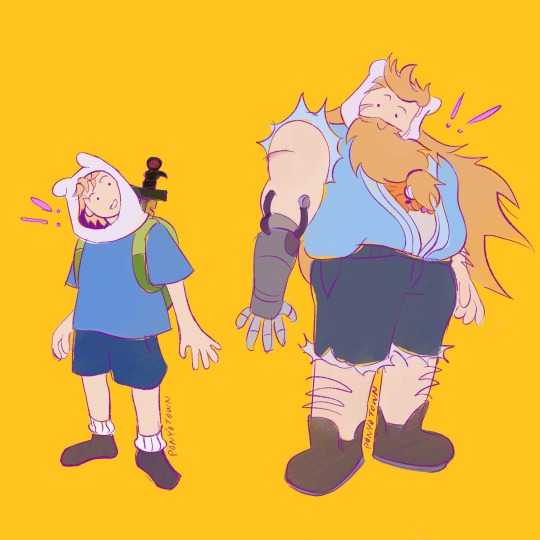
#artists on tumblr#art tag#digital art#adventure time#finn the human#fionna and cake#i love him so very much
27K notes
·
View notes
Text
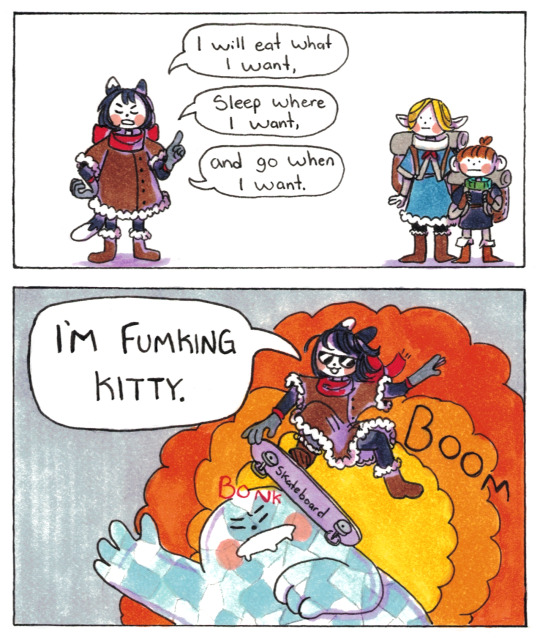
License to Kitty.
#dungeon meshi#izutsumi#marcille donato#chilchuk tims#I still stand by my tags on the Izutsumi character study piece I did in January - but I will repeat myself on a few lines here:#I *really* love this character. I love that all of the dungeon meshi crew are complicated and have difficult to love components.#But Izutsumi is a particular kind of hard to love. I foresee a lot of people being turned off by her abrasiveness and lack of teamwork.#She is very self-centered and openly goes against what the party agrees on.#She's a picky eater in a story that is 50% about eating good and healthy food!#It is in part about her growth but admittedly even *then* she remains rather true to her self-centeredness.#Even though she isn't as nice or funny or compassionate as the others...Izutsumi is still someone worth loving.#Even the more difficult people are someone worth loving.#And those people in turn are people who have something and someone they love.#She may be a girlcat but she is the most human of them all.#I hope that if you are an anime only watcher and are feeling put off by her at the moment; you'll give her a chance.#By the way: *yes* I worked very hard to draw that skateboard pose. It was worth it.#EDIT: HAPPY 500th POST OF POORLY-DRAW-MDZS!!! What a comic to commemorate the milestone with!
11K notes
·
View notes
Text
Wow! The human body is incredible!
I have officially reached the age where stretching too enthusiastically causes injury
#text post#time flies#and if I could fly that would probably hurt me too#very human#muffin activities#funny#I’ll try to curb my enthusiasm#just a few more years until sporadic bone breakage
0 notes
Text
"I am going to get a good grade in ___________, a thing that is both normal to want and possible to achieve" drifts through my brain with positively alarming regularity.
#this is because I managed to have an interesting conversation with my uncles at dinner#and also I had Work Stuff to do in front of my mother and felt so so proud of myself#sometimes being human is very ridiculous.#celestial emporium of benevolent knowledge
8K notes
·
View notes
Text
congrats to this Pinterest comment that sent me into a 2 am spiral (affectionate)
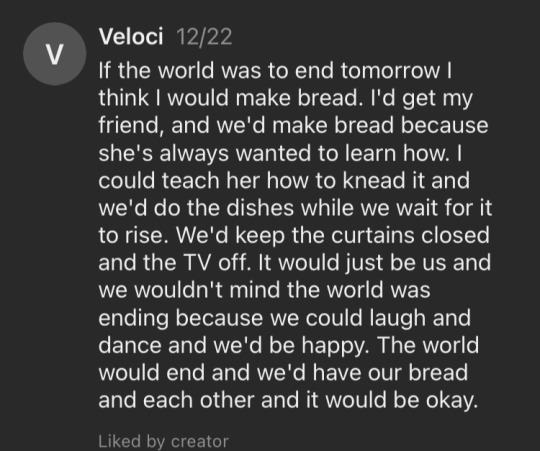
#comment section#end of the world#pinterest#Man.#people being people#human things#humanity#god this is so sad#But happy at the same time#Very human
1 note
·
View note